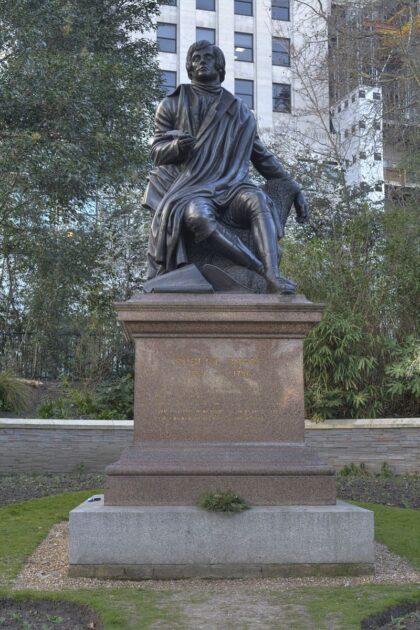Although Robert Burns is Scotland’s national bard, his influence spans across the English-speaking world. The London statue was commissioned in the 1880s by admirers of Burns who wished to commemorate his universal literary appeal, especially his themes of equality, nature, compassion, and national identity.
His works were incredibly popular in Victorian Britain, a time when poetry was widely read and admired by all social classes. Burns’s ability to articulate the struggles and dreams of ordinary people made him a figure of deep cultural respect throughout the UK.

Why Was the Statue Erected in Victoria Embankment Gardens?
Victoria Embankment Gardens was one of the newly developed public parks of the Victorian era, created as part of the grand Thames Embankment project (completed in the 1870s). It became a fashionable spot for commemorative statues and memorials, especially those celebrating figures of national or literary importance.
The Gardens offered a prestigious yet peaceful setting, ideal for reflection and tribute. Placing Burns here signaled his status as a national literary icon, not just a regional Scottish figure. It also symbolized unity—his presence among London’s other great monuments reflected a broader cultural belonging within the United Kingdom.
What Makes the London Statue of Robert Burns Unique?
- It was sculpted by Sir John Steell, one of Scotland’s most acclaimed sculptors, who also created the Burns statues in Dundee and Central Park, New York—adding international prestige.
- Burns is shown in a thoughtful, almost melancholic pose, standing with arms folded across his chest and gazing slightly downward. This is not the rugged ploughman image, but rather the contemplative poet and philosopher, lost in his own verse.
- His dress is that of an 18th-century gentleman, wearing a frock coat, breeches, and boots—dignified, yet humble.
- The realistic, life-size representation (around 7 feet high, with a 9-foot total including plinth) reflects the Victorian emphasis on lifelike, moral portraiture.
Unlike more exuberant or heroic statues of poets, this one invites quiet thought and connection with his inner world.
The Inscription and Plaque
At the base of the statue is a granite pedestal with bronze plaques. One plaque bears the name:
ROBERT BURNS
1759 – 1796
Another includes lines from one of his most famous egalitarian poems:
“A man’s a man for a’ that”
These words embody Burns’s belief in the inherent dignity and equality of all people—a sentiment that resonated strongly in the democratic spirit of Victorian reform movements and still holds power today.
Other plaques reference supporters who funded the statue, including public subscriptions by admirers in London and beyond.
Key Facts and Figures
- 📍 Location: Victoria Embankment Gardens, near Charing Cross and Embankment stations
- 🗿 Sculptor: Sir John Steell
- 📏 Height: ~9 feet (including plinth)
- 🗓️ Date Erected: Unveiled 25 July 1884
- 💬 Inscriptions: Includes “A man’s a man for a’ that”
- 🏛️ Material: Bronze statue, granite pedestal
- 🎖️ Commissioned By: The London Burns Club and public subscribers
A Short Biography of Robert Burns
Robert Burns (1759–1796) was born in Alloway, Ayrshire, into a farming family. Despite limited formal education, he became one of the greatest poets in the English language. His work, often written in the Scots dialect, championed the dignity of the common person, love of nature, and freedom of thought.
Famous works include:
- Auld Lang Syne (sung on New Year’s Eve worldwide)
- To a Mouse (which inspired Steinbeck’s Of Mice and Men)
- Tam o’ Shanter
- Ae Fond Kiss
Burns died at the age of just 37, but his legacy has endured for centuries. Burns Night, celebrated on January 25th, is an annual tradition filled with poetry, music, haggis, and whisky, honoring the enduring flame of his words.
Nearby Attractions You Can Visit
This is a fantastic area for sightseeing, and while visiting the Burns statue, you’re steps away from several other cultural landmarks:
- 🖼️ The National Gallery – World-class art museum, 7 mins away
- 🎭 Trafalgar Square – With Nelson’s Column and frequent events
- 🚇 Embankment Pier & Riverwalks – Lovely for a scenic stroll or boat ride
- 🕰️ Big Ben & Westminster – About a 10-minute walk along the Thames
- 🎡 The London Eye – Just across the river via Hungerford Bridge
- 🌳 St. James’s Park – Ideal for a peaceful walk or picnic
- 🪙 Cleopatra’s Needle – An ancient Egyptian obelisk nearby on the Embankment


